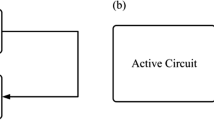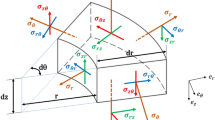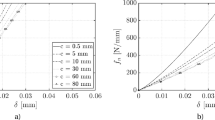Abstract
In this study, the formula to calculate the impact factor of coupling (ξ) was proposed, considering the thermo-mechanical coupling problem of friction pairs for braking device during braking. First, a correlation between independent physical field parameters was provided by analyzing the interaction parameters of stress and temperature field. Next, the thermal analysis and thermo-mechanical strong coupling analysis were completed for friction pairs using heat transfer module and structural mechanics module of COMSOL multiphysics software on the basis of the actual operating situation of a pipe belt conveyor. The distribution and variation characteristics of the temperature and stress fields were studied with comparative analysis for braking friction pairs during braking. The mathematical expression on the impact factor of coupling (ξ) depending on braking time (t) was established. Finally, the model with thermo-mechanical strong coupling analysis was verified and compared with the thermal analysis model in terms of the measured surface temperature during braking. Simulation results revealed that the impact factor of coupling (ξ) decreased with braking time (t). However, the change rate of function initially decreased and then increased with time. An inflection point existed at t = 1.5396 s in the function ξ of t. In comparison with the small fluctuation of the simulations with thermal analysis model, the simulations with thermo-mechanical strong coupling analysis model were in good agreement with the trend of experimental results, and all the maximum relative errors were less than 4 %. Thus, the simulation with thermo-mechanical strong coupling analysis was more reliable than thermal analysis. This work could provide valuable insights in solving complex multiphysics coupling analysis.
Similar content being viewed by others
References
Y. C. Guo, S. Wang, K. Hu and D. Y. Li, Optimization and experimental study of transport section lateral pressure of pipe belt conveyor, Adv. Powder Technol., 27 (4) (2016) 1318–1324.
G. Fedorko, V. Molnar, M. Dovica, T. Toth and M. Kopas, Analysis of pipe conveyor belt damaged by thermal wear, Eng. Failure Anal., 45 (2014) 41–48.
V. Molnar, G. Fedorko, B. Stehlikova, P. Michalik and M. Kopas, Influence of tension and release in piped conveyor belt on change of normal contact forces in hexagonal idler housing for pipe conveyor loaded with material, Meas., 84 (2016) 21–31.
M. E. Zamiralova and G. Lodewijks, Energy consumption of pipe belt conveyors: indentation rolling resistance, FME Trans., 40 (2012) 171–176.
V. Molnár, G. Fedorko, M. Andrejiová, A. Grinčová and M. Tomašková, Analysis of influence of conveyor belt overhang and cranking on pipe conveyor operational characteristics, Meas., 63 (2015) 168–175.
X. Feng, J. Z. Zhou, D. Mu, Y. F. Mei and W. L. Zhu, Analysis of temperature distribution in brake discs having a textured surface produced by laser peening, Lasers Eng., 36 (1–3) (2017) 185–198.
K. W. Liew and U. Nirmal, Frictional performance evaluation of newly designed brake pad materials, Mater. Design, 48 (2013) 25–33.
S. C. Wu, S. Q. Zhang and Z. W. Xu, Thermal crack growthbased fatigue life prediction due to braking for a high-speed railway brake disc, Int. J. Fatigue, 87 (2016) 359–369.
S. E. Alam, Y. Vidhyadhar, P. Sharma and A. Jain, Thermal analysis of disc brakes rotor: a comparative report, J. Inf. Sci. Comput. Technol., 3 (2) (2015) 196–200.
U. I. Bhatti and W. Y. Ochieng, Failure modes and models for integrated GPS/INS systems, J. Navigation, 60 (2) (2007) 327–348.
F. Jiang, W. B. Yu, Z. Ye, R. Kerans and M. Y. Chen, Analysis of reusable integrated thermal protection panel elements with various insulating core options, 55th AIAA/ ASME/ ASCE/ AHS/ SC Structures, Structural Dynamics, and Materials Conference, National Harbor, Maryland (2014) 0351.
C. T. Davie, C. J. Pearce and N. Bićanić, Fully coupled, hygro-thermo-mechanical sensitivity analysis of a pre-stressed concrete pressure vessel, Eng. Struct., 59 (2014) 536–551.
P. Hwang and X. Wu, Investigation of temperature and thermal stress in ventilated disc brake based on 3D thermomechanical coupling model, J. Mech. Sci. Technol., 24 (1) (2010) 81–84.
A. Adamowicz and P. Grzes, Influence of convective cooling on a disc brake temperature distribution during repetitive braking, Appl. Therm. Eng., 31 (14) (2011) 2177–2185.
M. Duzgun, Investigation of thermo-structural behaviors of different ventilation applications on brake discs, J. Mech. Sci. Technol., 26 (1) (2012) 235–240.
D. Meng, L. Zhang and Z. Yu, Modeling and simulation of brake judder considering the effects of thermo-mechanical coupling, J. Vibroeng., 16 (7) (2014) 3637–3654.
V. Dadi, K. Rao and J. H. N. Rao, Structural and thermal analysis of disc brake with and without cross drilled rotor, Int. J. Eng. Adv. Technol., 3 (9) (2015) 477–482.
X. P. Li, D. H. Sun, Y. J. Liang and G. H. Zhao, Thermalstructure coupling characteristics of brake’s rotating joint surface, J. Northeast. Univ., Nat. Sci., 36 (4) (2015) 521–526.
Y. Wang, J. M. Wang, Y. Q. Huang and S. J. Li, Calculation method for dynamic load coefficients of drive shafts of oil-film bearing, Lubr. Eng., 40 (1) (2015) 86–91.
R. Schittny, M. Kadic, S. Guenneau and M. Wegener, Experiments on transformation thermodynamics: Molding the flow of heat, Phys. Rev. Lett., 110 (19) (2013) 195901.
J. M. Coulson, J. F. Richardson, J. R. Backhurst and J. H. Harker, Fluid flow, heat transfer and mass transfer, Filtr. Sep., 33 (2) (1996) 102.
S. J. Li, Y. Wang, D. Xiang and W. J. Meng, Impact factor of binding interface on ZChSnSb11-6/20 steel composites, Rare Met. Mater. Eng., 45 (10) (2016) 2555–2560.
A. A. Yevtushenko and P. Grzes, The FEM-modeling of the frictional heating phenomenon in the pad/disc tribosystem (A review), Numer. Heat Transfer, Part A, 58 (3) (2010) 207–226.
D. Chan and G. W. Stachowiak, Review of automotive brake friction materials, Proc. Inst. Mech. Eng., Part D, 218 (9) (2004) 953–966.
H. S. Qi and A. J. Day, Investigation of disc/pad interface temperatures in friction braking, Wear, 262 (5) (2007) 505–513.
W. B. J. Zimmerman, Multiphysics modeling with finite element methods, World Scientific Publishing Co. Inc, Singapore (2006).
S. J. Wen and P. Huang, Principles of tribology, 3rd Edition, Tsinghua University Press, Bejing, China (2008).
Q. W. Wang, Y. Ren, Y. Wang and H. Wen, Research on temperature measurement of dynamic braking performance test system of brake, Hosting Conveying Mach., (5) (2011) 51–54.
A. A. Yevtushenko, P. Grzes and A. Adamowicz, Numerical analysis of thermal stresses in disk brakes and clutches (A review), Numer. Heat Transfer, Part A, 67 (2) (2015) 170–188.
Y. Wang, J. M. Wang, H. Wen and J. F. Kang, Extrusion effect model of friction lining on drum brake, Lubr. Eng., 37 (9) (2012) 66–69.
Author information
Authors and Affiliations
Corresponding author
Additional information
Recommended by Associate Editor In-Ha Sung
Yao Wang received his B.S. and M.S. degrees in Mechanical Design and Theory from Taiyuan University of Science and Technology (TYUST) in 2011 and 2014, respectively. He is currently a Ph.D. candidate at TYUST in China and a research scholar at Auburn University, USA. His research interests include system dynamics and multiphysics coupling simulation.
Rights and permissions
About this article
Cite this article
Wang, Y., Li, S. & Meng, W. Thermo-mechanical strong coupling analysis on braking device of pipe belt conveyor. J Mech Sci Technol 32, 1277–1285 (2018). https://doi.org/10.1007/s12206-018-0232-7
Received:
Revised:
Accepted:
Published:
Issue Date:
DOI: https://doi.org/10.1007/s12206-018-0232-7




